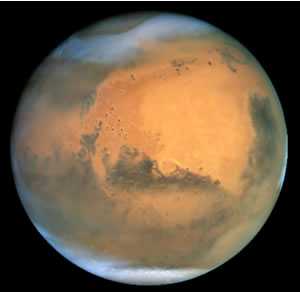Astronomers studying enigmatic grooves on the surface of Mars have uncovered secrets about the planet's historic climate. In a paper published in Nature this week, Isaac Smith and John Holt of the University of Texas Institute for Geophysics analyse new radar images of the grooves taken by the American Mars Reconnaisance Orbiter and the European Mars Express spacecraft, and they've found that beneath each of the grooves, there are indentations in all of the stratified layers of deposit down to a depth of almost 700 metres.
 That was a startling result, because many people had thought these were merely scratch-like features carved out by erosion, extending down to a few tens of metres. We can now discard those theories as they have no way of explaining why the sub-surface geology is as much affected as the surface. A much better theory is that there is some finely-balanced combination of wind erosion and deposition at work, which is keeping the troughs remarkably stable and well-preserved as new layers of material are laid down on top of them. If that is right, then it's possible to guess the age of the features, assuming that material is deposited at a rate of around a millimetre per year, and the answer is that they must be between 500,000 and two million years old.
That was a startling result, because many people had thought these were merely scratch-like features carved out by erosion, extending down to a few tens of metres. We can now discard those theories as they have no way of explaining why the sub-surface geology is as much affected as the surface. A much better theory is that there is some finely-balanced combination of wind erosion and deposition at work, which is keeping the troughs remarkably stable and well-preserved as new layers of material are laid down on top of them. If that is right, then it's possible to guess the age of the features, assuming that material is deposited at a rate of around a millimetre per year, and the answer is that they must be between 500,000 and two million years old.
That is fascinating, because it's potentially telling us about Martian weather systems not just today, but hundreds of thousands of years ago. Smith & Holt have looked at various possible wind-driven processes which could be responsible for the grooves, and find that quite a complicated cocktail of wind erosion and particle transport is needed to keep the troughs in a steady equilibrium. Given the delicacy of the conditions required, the findings seem to preclude any recent climate change on Mars.










Comments
Add a comment